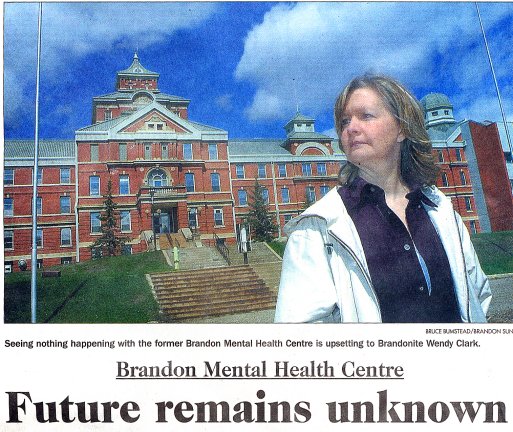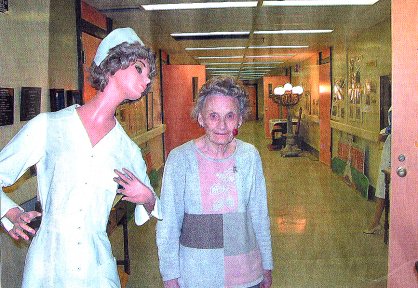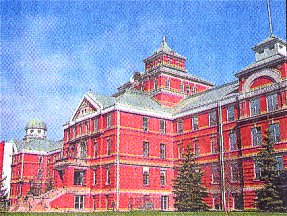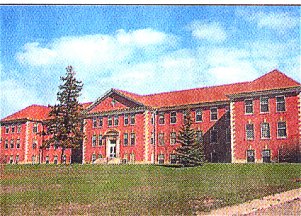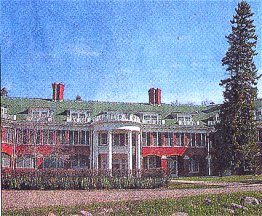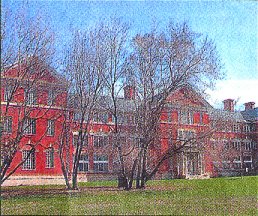Silence overwhelms a first-time visitor to the
Brandon Mental Health Centre's Parkland Building
It's a quiet solitude Jaye Little has grown used to. A
nurse at the site for 38 years, today she shows off the artifacts used
when this monolithic building on the North Hill housed hundreds of mental
health patients from across the province.
Thirty years ago, these halls would have been buzzing
with activity. Today, you can only hear the buzz of the lights as you step
from room to room, looking at the old pictures and antique medical equipment.
Little crosses her fingers that one day, there will be
activity in this old building again.
"I was really hoping Assiniboine Community College would
come up here and they could let me stay in this spot," said Little, who
has run various incarnations of the BMHC museum since 1972.
The four main buildings of BMHC sit empty like the ruins
of some ancient civilization today. Save for the chirping of birds and
the distant sound of highway traffic, not much breaks the silence drowning
the verdant grounds.
But not all is quiet on the BMHC front.
By June 1, the provincial government and the city of Brandon
will hire a facilitator to find "options" for the site through public meetings
and a call for proposals from developers, options that five years after
BMHC closed remain elusive to Little and to western Manitoba.
The BMHC grounds may be an island of tranquility on this
beautiful spring morning, b ut down in the valley the roar of the rhetoric
is guaranteed to grow louder in the coming days.
The be-all, end-all solution for one side is to move ACC
from its crowded campus in the east end to the sprawling site on the NOrth
Hill.
The other side, meanwhile, finds the $66.5-million price
tag for doing that too expensive. This group -- which includes the politicians
picking the facilitator -- want to start over, looking at other things
the grounds can be used for.
Whatever happens, Little knows one thing for sure.
"If ACC doesn't come up here, the mayor will have to find
a place for the museum. And I will bug him, believe me," she said.
From Asylum to the Community
What is now the Brandon Health Centre began as a boys'
reformatory in 1890. Only one boy was held there, sentenced to five years'
imprisonment for stealing a letter. In 1891, the government decided to
transfer patients from the crowded Selkirk Insane Asylum to the Brandon
Asylum for the Insane.
In 1910, the asylum burnt down, prompting the government
to rebuild. Between 1912 and 1932, the four main buildings of BMHC were
built, followed later by a trades building, a doctor's residence, new barns
and a new laundry facility.
By the 1980s, though, the shutdown process began.
Norwood Gardens was closed in 1980 and torn down. Between
1986 and 1988, groups of patients were moved to Dinsdale Park, Rideau Park
and the Brandon General Hospital's Assiniboine Centre.
In 1922, the Valleyview building was closed for good.
By 1999, the doors were shut to the Pine Ridge Building, the Nurses' Residence
and the Parkland Building.
As the regional director for the Canadian Mental Health
Association, Glen Kruck was trying to help patients make the transition
to living in the community.
While the philosophy behind "care in the community" has
been hotly debated since BMHC emptied, Kruck believes moving people out
was the right choice.
"The overwhelming majority of people who were there did
not want to live there. They wanted to live in the community," Kruck said.
Today, only Little and a group of employees that run the
power plant regularly see the inside of the facility.
And since the last patient left the confines of BMHC to
the city in the valley below, a process has begun that five years later
is starting to come full circle.
BOVA: 'I Don't Care'
In 1999, Joe Bova came to Brandon after a successful turn
at revitalizing Winnipeg's Corydon Avenue. As the front man for the newly-formed
Development Consortium, a Winnipeg-based group of architects and developers,
it was part of Bova's job to turn ian empty mental institution into something
viable.
Half a decade later, after working with the city and provincial
governments on a solution that never came, Bova prefers not to look back.
"We had a few things I thought we could have done, otherwise
we would have not been involved. But that was yesterday," Bova said.
"I'm not too far away, too far out. I don't know what's
going on. And honestly, I don't care."
But in April 1999, Bova and the Development Consortium
released their vision for the site, a thick report called Opportunities
for Renewal that the city and province paid $75,000 to have done.
It reviewed the state of BMHC's four main buildings and
came up with a blueprint for the site, a plan to mix housing and recreational
development glued together with a village-green atmosphere and a
pedestrian area around the main buildings.
Central to the theme was ensuring the historic buildings
and natural environment be preserved while keeping the lands accessible
to the public.
Steve Cohlmeyer, the Development Consortium's architect
believes the campus layout is what makes BMHC what it is.
"The campus is more important than any single building
on he site," Cholmeyer said.
"Certainly walking through there . . . was like walking
through an Ivy League campus. It has a very special kind of appeal and
is something not to throw away."
And in that sense, Cohlmeyer is at least glad that BMHC
wasn't thrown away. After all, the provincial government planned to hand
the City of Brandon the land plus the money required to tear down the buildings.
Reg Atkinson was the mayor during this time. He signed
a deal with the provincial government to turn BMHC over to the city, but
it was never followed through on because of a new possibility for BMHC
-- Assiniboine Community College.
Turning Point
In 2000, the city agreed to forgo the $150,000 operating
grant it was getting from the province while the buildings sat mothballed.
That decision has cost the city $600,000 in lost revenue. Meanwhile, the
provincial government has shelled out $2.1 million since 1999 to keep the
buildings in cold storage.
But while the city made concessions, the idea of moving
ACC to BMHC -- the idea now paralyzing the debate -- began to take hold.
"It put everything else on hold. In hindsight, (signing
the deal) was a mistake. We should have gone ahead initially, taken our
$1.5 million and if we had someone wanting to develop part of it we could
have said "OK, here's 100 grand," Atkinson said.
Renex Corporation, Bova's company, told the government
in 201 that it would take between $31 and $36 million to move the college
-- a price the NDP considered too high.
At that point, Renex had the first right of refusal on
a sale of the land. Bova said he'd reconsider purchasing it if ACC didn't
move to BMHC.
A second price tag was sought. In March 2003, Winnipeg-based
architects needed $66.5 million to renovate the Parkland Building and construct
a new trades building for the college. That's $12 million higher than the
estimate to renovate and expand ACC in the east end.
Steve Corbett, who studied BMHC with his partner George
Cibinel, says ACC would need a new building for trades because the heavy
concrete-and-brick construction of BMHC's buildings wouldn't convert easily
to shops.
Yet he recommended the government move the college rather
than expand the east end because of the significance and the solid construction
of BMHC.
"If the buildings were heated and fixed up, 200 years,"
he said when asked how long BMHC's buildings could stand.
"Each building needs maintenance, but those buildings
could last quite a while."
That report stayed under wraps for more than a year, until
in November 2003 the region got a surprise when the DP government changed
tack and said it would work with the city and developers on "options" for
the site.
The surprise sat the worst within the New Democratic Party.
It highlighted a long-latent fracture in the party by dividing members
who wanted the college to move from those in government who said it would
be too expensive.
Eventually, a seven-member group was formed which will
hire a facilitator to get proposals from developers and listen to community
input this summer before writing a recommendation later this year.
Transpiration and Government Services MInister Ron Lemieux,
who co-chairs the committee with brandon Mayor Dave Burgess, said he's
proud of the pro cess.
"We've defined a good process," Lemieux said. "Now we
have to continue and diligently work through it. We have to say 'Look it.
Everything is on the table. Please come forward with suggestions with what
you'd like to see.'"
Sustainable Development
The debate sure to plug up the public meetings centres
on whether it's right to move ACC to BMHC for $66.5 million and what other
developments can work.
Wendy Clark has an idea.
The organic inspector and environmentalist would like
BMHC turned into an international centre for sustainable development.
She proposes the centre would house ACC's agricultural
and environmental programs and would offer courses in organic agriculture,
ecology and environmental sustainability.
Clark says it could be a model in environmental sustainability
itself, built to standards similar to those used on revamped heritage buildings
like Winnipeg's MOuntain Equipment Co-op building and REd River College's
Princess Street campus.
While there would be a cost, Clark says it would pay for
itself by being a magnet for environmental education in North America.
"The list is endless, really, of all the things we could
be doing," said Clark.
David Barnes has been one of the most active advocates
for ACC at BMHC. He fell in love with the spot years ago when he started
watching birds there and believes it could be the perfect spot for environmental
education.
"There's huge opportunities there because of the amount
of space," said Barnes, stressing especially on the 252 acres the city
appropriated from the RM of Cornwallis two years ago that surround BMHC.
But Mayor Dave Burgess says whatever goes there, it must
not drain the city treasury.
He wants the buildings preserved, but not at any cost.
He's wary for seeing millions go into BMHC for the past five years with
nothing to show for it.
"The decision process took five years, or more now, and
cost us all a tremendous amount of money to have it in neutral. It' s very
much a shame. It's a waste of money," he said.
Putting an end to that annual waste will be one of the
underlying forces when the development process starts up again this year.
Everything Under The Sun
The ideas for the site are endless and that, perhaps,
is part of the problem.
Cohlmeyer's vision was always to have the different aspects
of the site link together without losing the public aspect.
He says that should include a mix of development that
above all preserves the main buildings.
Other ideas came out at public workshops in 1999 and will
likely come out again this summer during the public meetings.
A 27-hole golf course, museums, condominiums, terminal-care
hospices, media production centres and a native village were just a sampling
of the suggestions when Cohlmeyer, Bova and TDC did their report. Other
written proposals from developers included creating a wellness centre,
a Brandon Country Club, a Christian family resource centre and seniors
housing.
Some people really think outside the box. Brandonite Lionel
Dane believes the Canadian Parliament should be moved from Ottawa to "central
Canada" -- Brandon's North Hill. Here's a piece of the proposal he sent
the Sun:
"A portion of the main building could be restored for
its original intent so that treatment could be given to all members who
suffer delusions of self-importance and a separate padded room could be
constructed to offer treatments, of a shocking nature, for those who suffered
from a sponsorship, self-imposed, phobia."
Whether realistic or with a touch of satire, a better
idea will be known by the end of this year, when a call for proposals goes
out ot interested developers.
'Going In Circles'
Burgess says the difference between what happened in 1999
and what's happening today is that by August, a call for formal proposals
will go out to interested developers and a suitable use will be found by
January.
When asked what he considers a suitable use, he doesn't
want to speculate.
"We may have some come forward that we haven't even though
of yet . . . and it may even come to pass that we might not have any that
are acceptable. That's something that we may have to face," Burgess said.
Atkinson believes this new process will be a waste of
time and energy because it will repeat the work that was already done in
the late 1990s.
He thinks the NDP government is more afraid of the political
cost of going forward than the financial cost because its own supporters
will rip them if it decides to knock part of BMHC down or sell pieces off
to private developers.
"People want to save everything. What are they trying
to save? The memories, the stories, or the bricks? You can't save all the
bricks," he said.
Lemieux says the process is not a matter of "going in
circles." He says the government values the input of western Manitobans
and want s them to have a hand in whatever decision is made.
"You have to trust in people," he said. "People will make
the right decisions. They understand this is financially challenging and
won't be easy."
But there is little trust right now.
Like many who want to see the buildings preserved, Little
is guided not so much by what she hears but by what she feels over the
questions of BMHC.
For now, she'll keep at her museum, surrounded by silence
and uncertainty.
"I was hoping something could have happened by now," she
said.
"I just have this horrible feeling that they will knock
these buildings down."
